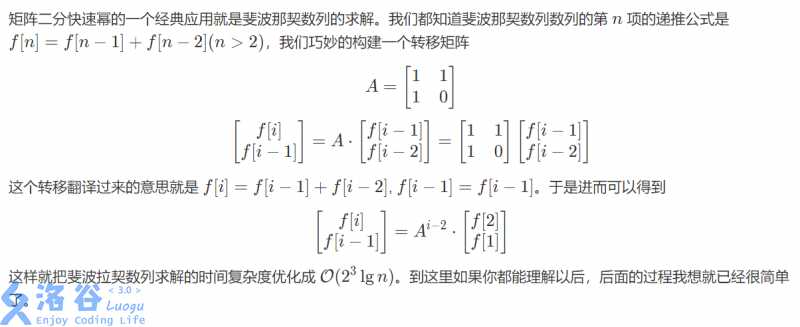矩阵快速幂
Posted hkttg
tags:
篇首语:本文由小常识网(cha138.com)小编为大家整理,主要介绍了矩阵快速幂相关的知识,希望对你有一定的参考价值。
P1962 斐波那契数列
题目背景
大家都知道,斐波那契数列是满足如下性质的一个数列:
• f(1) = 1
• f(2) = 1
• f(n) = f(n-1) + f(n-2) (n ≥ 2 且 n 为整数)
题目描述
请你求出 f(n) mod 1000000007 的值。
输入输出格式
输入格式:·第 1 行:一个整数 n
输出格式:第 1 行: f(n) mod 1000000007 的值
输入输出样例
输入样例#1:
5
输出样例#1:
5
输入样例#2:
10
输出样例#2:
55
说明
对于 60% 的数据: n ≤ 92
对于 100% 的数据: n在long long(INT64)范围内。
——————————————————————————————————————————
100%的数据很大,普通线性求解效率很低,需要用矩阵快速幂加速。

code
#include <cstdio> #include <cstring> #include <cstdlib> #include <iostream> #include <algorithm> using namespace std; typedef long long LL; const int N = 2; const int MOD = 1e9 + 7; LL n, m; struct Node { LL g[N + 2][N + 2]; }f, res; void matrixI(Node &x) { for (int i = 1; i <= N; ++ i) for (int j = 1; j <= N; ++ j) { if (i == j) x.g[i][j] = 1LL; else x.g[i][j] = 0LL; } } void matrixMul(Node &x, Node &y, Node &z) { memset(z.g, 0, sizeof(z.g)); for (int i = 1; i <= N; ++ i) for (int j = 1; j <= N; ++ j) if (x.g[i][j]) { for (int k = 1; k <= N; ++ k) { z.g[i][k] += x.g[i][j] * y.g[j][k]; if (z.g[i][k] >= m) z.g[i][k] %= m; } } } void matrixPow(LL k) { matrixI(res); Node temp = f, t; while (k) { if (k & 1) { matrixMul(res, temp, t); res = t; } matrixMul(temp, temp, t); temp = t; k >>= 1; } } LL solve() { if (n <= 2) return 1LL; matrixPow(n - 2); LL ret = res.g[1][1]*1 + res.g[2][1]*1; if (ret >= m) ret -= m; return ret; } int main() { cin >> n; m = MOD; f.g[1][1] = 1; f.g[1][2] = 1; f.g[2][1] = 1; f.g[2][2] = 0; cout << solve() << endl; return 0; }
P1349 广义斐波那契数列
题目描述
广义的斐波那契数列是指形如an=p*an-1+q*an-2的数列。今给定数列的两系数p和q,以及数列的最前两项a1和a2,另给出两个整数n和m,试求数列的第n项an除以m的余数。
输入输出格式
输入格式:输入包含一行6个整数。依次是p,q,a1,a2,n,m,其中在p,q,a1,a2整数范围内,n和m在长整数范围内。
输出格式:输出包含一行一个整数,即an除以m的余数。
输入输出样例
输入样例#1:
1 1 1 1 10 7
输出样例#1:
6
说明
数列第10项是55,除以7的余数为6。
code
本题是Fibonacci的扩展,更换单位矩阵即可
#include <cstdio> #include <cstring> #include <cstdlib> #include <iostream> #include <algorithm> using namespace std; typedef long long LL; const int N = 2; const int MOD = 1e9 + 7; LL n, m; struct Node { LL g[N + 2][N + 2]; }f, res; void matrixI(Node &x) { x.g[1][1] = a2; x.g[1][2] = a1; x.g[2][1] = 0; x.g[2][2] = 0; } void matrixMul(Node &x, Node &y, Node &z) { memset(z.g, 0, sizeof(z.g)); for (int i = 1; i <= N; ++ i) for (int j = 1; j <= N; ++ j) if (x.g[i][j]) { for (int k = 1; k <= N; ++ k) { z.g[i][k] += x.g[i][j] * y.g[j][k]; if (z.g[i][k] >= m) z.g[i][k] %= m; } } } void matrixPow(LL k) { matrixI(res); Node temp = f, t; while (k) { if (k & 1) { matrixMul(res, temp, t); res = t; } matrixMul(temp, temp, t); temp = t; k >>= 1; } } LL solve() { if (n == 1) return a1 % m; else if (n == 2) return a2 % m; matrixPow(n - 2); LL ret = res.g[1][1]*1 + res.g[2][1]*1; if (ret >= m) ret -= m; return ret; } int main() { cin >> p >> q >> a1 >> a2 >> n >> m; f.g[1][1] = p; f.g[1][2] = 1; f.g[2][1] = q; f.g[2][2] = 0; cout << res << endl; return 0; }
以上是关于矩阵快速幂的主要内容,如果未能解决你的问题,请参考以下文章